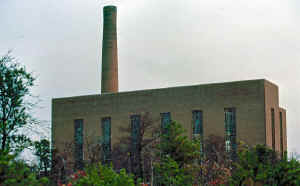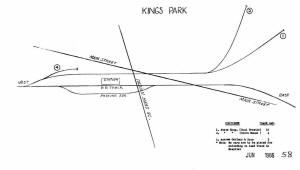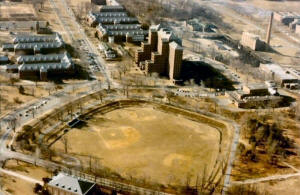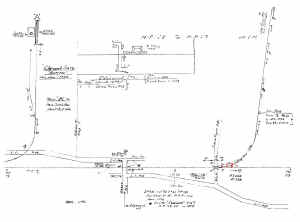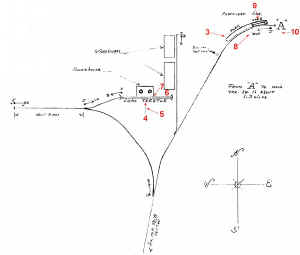
EDGEWOOD
STATION: TWO STOREY WOODEN DEPOT BUILT BY
LAND DEVELOPER. OPENED: 6/1892 AS SIGNAL STOP. NO TRAINS STOPPED
THEREAFTER ETT #61, EFF. JUNE/1911. LAST APPEARS ON ETT #72, EFF:
10/21/1913.
ABANDONED. USED BY LOCALS AS A SOURCE FOR SCRAP LUMBER (Geo. G.
Ayling first-hand data). BURNED: 1920 Research: Dave Keller
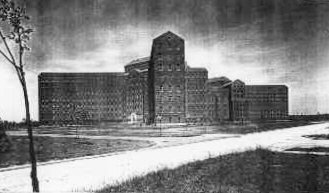 Edgewood
Edgewood
The hospital was built in the early 1940s, believed to be a Works Progress Administration funded project. It consisted only of ten buildings (including its massive, prominent 13-story main building), making it the smallest of the four as well (although it was planned to be a larger complex, those plans never made it past paper). The facility was commandeered by the War Department after the United States entered World War II. The War Department completed its construction for use as a psychiatric facility for battle-traumatized soldiers. Its entire campus (in addition to three buildings from nearby Pilgrim State Hospital and numerous temporary structures) was used as "Mason General Hospital" (left) by the department. When the war ended, the hospital was transferred back to New York State, where it essentially operated as the tubercular division of Pilgrim for a few years.
The hospital operated between 1944 and 1946, and was used for treating the psychological casualties of the battlefield as well as for other related uses. During the hospital's brief operation, in 1946 film director John Huston was assigned by the US government to film a documentary film about recovering soldiers in the hospital for propaganda purposes, the film was called "Let There Be Light". The film showed the steps that shell-shocked soldiers took in their rehabilitation towards a normal life after discharge. However, the film was deemed so potentially controversial that the government kept it hidden from the public until 1981.
After
1946, the War Department handed control of Mason General back to New York
State, where Edgewood Hospital was managed by Pilgrim, and the three
buildings at Pilgrim that partially comprised Mason, 81, 82, and 83,
reverted to their parent complex.
Today, the site sits as an open, state-protected oak-brush plains preserve under the NYS DEC department. One can still find remnants of the former hospital, such as the old rail spur, fire hydrants, etc., scattered about. Info: Wikipedia
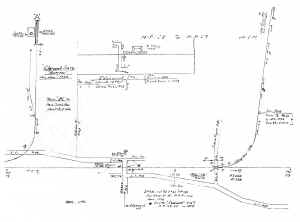
Map of MP 38-39 Edgewood State Hospital spur/siding at the left and the former Edgewood station site in the center, effective May, 1958. (Robert Emery map, Dave Keller archive)
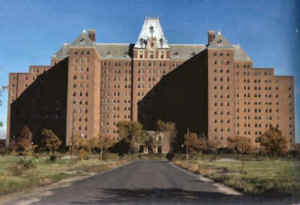
Edgewood Hospital - view E Photo/Archive Art Huneke
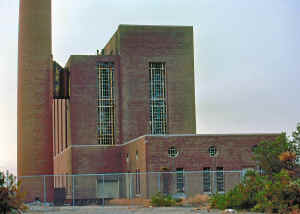
Edgewood Hospital - view S 11/09/1987 Photo: Edward Hand
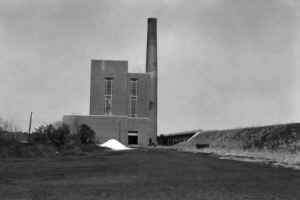
Edgewood Hospital power house view N Photo/Archive Art Huneke
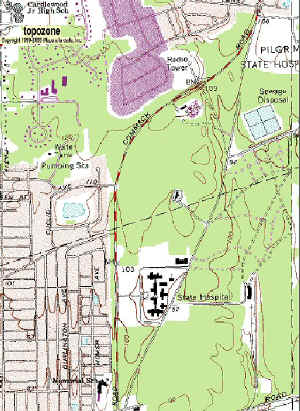
Edgewood Hospital - topographical map 1966
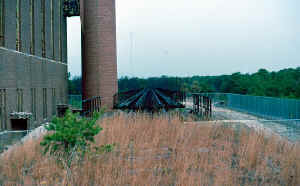
Edgewood Hospital coal trestle - view N 11/09/1987 Photo: Edward Hand
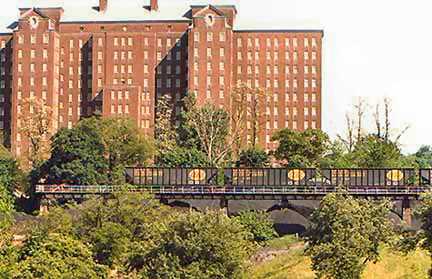 Coal
dock at the Kings Park Hospital Photo: John Volpi - The Kings Park
Psychiatric Center was established in 1885 by Kings County in nearby Suffolk
County. The official name of the hospital in its first 10 years was the
Kings County Asylum, taken from the name of the county that Brooklyn
occupied. The hospital was revolutionary at the time in the sense that it
was a departure from the asylums of folklore, which were overcrowded places
where gross human rights abuses often occurred. The asylum, built by
Brooklyn to alleviate overcrowding in its own asylums, was a "farm colony"
asylum, where patients worked in a variety of farm-related activities, such
as feeding livestock and growing food, as this was considered to be a form
of therapy.
Coal
dock at the Kings Park Hospital Photo: John Volpi - The Kings Park
Psychiatric Center was established in 1885 by Kings County in nearby Suffolk
County. The official name of the hospital in its first 10 years was the
Kings County Asylum, taken from the name of the county that Brooklyn
occupied. The hospital was revolutionary at the time in the sense that it
was a departure from the asylums of folklore, which were overcrowded places
where gross human rights abuses often occurred. The asylum, built by
Brooklyn to alleviate overcrowding in its own asylums, was a "farm colony"
asylum, where patients worked in a variety of farm-related activities, such
as feeding livestock and growing food, as this was considered to be a form
of therapy.
After World War II, patient
populations at Kings Park and the other Long Island asylums increased
markedly. In 1954, the patient census at Kings Park topped 9,303, but would
begin a steady decline afterward. By the time Kings Park reached its peak
patient population, the old "rest and relaxation" philosophy surrounding
farming had been succeeded by more invasive techniques of pre-frontal
lobotomies and electroshock therapy. However, those methods were soon
abandoned after 1955, following the introduction of Thorazine, the first
widely used drug in the treatment of mental illness. As medication made it
possible for patients to live normal lives outside of a mental institution,
the need for large facilities such as Kings Park diminished, and the patient
population began to decrease. In addition, activists worked in legal suits
through the 1970s to reduce the patient population in major institutions,
arguing that people could better be supported in smaller community centers.
By the early 1990s, the Kings Park Psychiatric Center, as it came to be
known, was much reduced. Many of the buildings were shut down or reduced in
usage. This included the massive Building 93. By the early 1990s, only the
first few floors of the building were in use. While many patients were
de-institutionalized and large facilities were closed, there was a shortage
of small community centers, which were never developed in the number needed.
This resulted in many more mentally ill people being caught up and retained
in jails and prisons because of difficulties in dealing with the world. Many
of the homeless in urban areas are mentally ill, people with chronic
illnesses who have difficulty keeping up with medication regimes or resist
them.
In response to the declining patient population, the New York State Office
of Mental Health developed plans to close Kings Park as well as another Long
Island asylum, the Central Islip Psychiatric Center, in the early 1990s. The
plans called for Kings Park and Central Islip to close, and the remaining
patients from both facilities to be transferred to the still-operational
Pilgrim Psychiatric Center, or be discharged. In the fall of 1996, the plans
were implemented. The few remaining patients from Kings Park and Central
Islip were transferred to Pilgrim, ending Kings Park's 111-year run. Source:
Wiki

Kings Park State Hospital Powerhouse c.1905 In 1885 Kings County purchased 873 acres in the town of Smithtown for an "asylum for the insane." It grew rapidly and was taken over by the state in the 1890s. The hospital became a major institution, and had its own power plant, sewage plant, water system, and its own farms. It made its own electricity 10 years before the creation of LILCO. This powerhouse was the third one, built c1905. The other buildings below were built in the 1890s. A community grew around the campus, and in 1891 became known as Kings Park. Archive: David Flynn
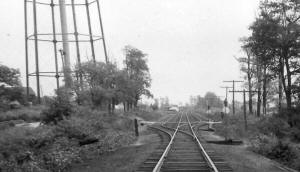
1st Ave., Kings Park - View E c.1940's
Archive: Ernie Lanzer
Note: The switch was moved to east of Indian Head Road in March 1967
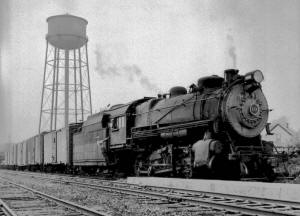
LIRR #113 H10s 2-6-0 entering the King Park spur
at the station platform.
View NW c.1940's Archive: Ernie Lanzer
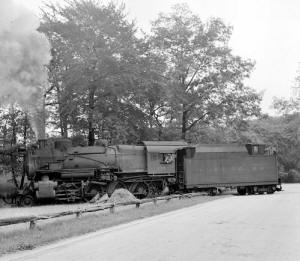
LIRR #113 H10s 2-8-0 crossing Main St./25A, Kings Park c.1950 Photo: Ernie Lanzer Archive: Kings Park Heritage Museum
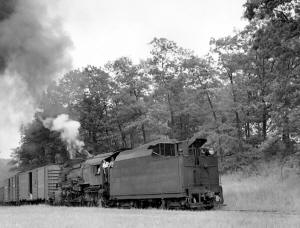
LIRR #113 freight bound for Kings Park State Hospital c.1950 Photo:
Ernie Lanzer Archive: Kings Park Heritage Museum

After unloading visitors to Kings Park State Hospital, the train would back from the hospital station, and cut off all but one car. The one car became a crew car as the train went the rest of the way to Port Jefferson to be turned on the wye, then back to Kings Park State Hospital to pick up the return train and riders.
The attached image shows G5s #37 pulling that one-crew-car hospital train back west to Kings Park State Hospital , passing G5s #s 48, 28 and 49 laying up in the West Yard, Port Jefferson in October, 1940. Photo: A. Seibel - Archive/Research: Dave Keller
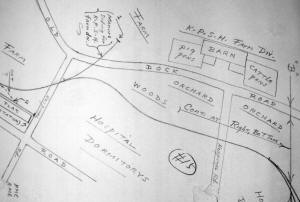
Kings Park State Hospital Emery map Old Dock Rd. 9/1957 Archive: SUNY Stony
Brook
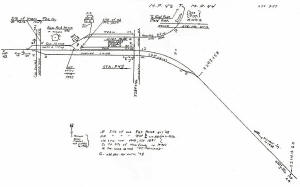
MP43-44 Kings Park Emery Map 9/1957
Archive: Dave Keller
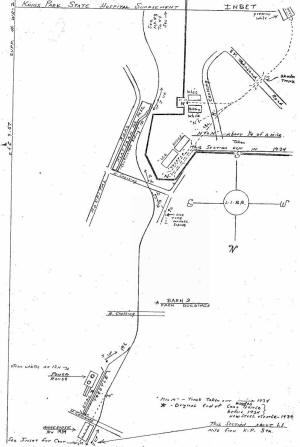
Kings Park Hospital Spur Emery Map 9/1957 Archive: Dave Keller
_small.jpg)
G5s #50 departing Kings Park State Hospital 6/29/1936 (Harrison-Keller)
_small.jpg)
H10s #111 freight Kings Park State Hospital spur c. 1952 (Krause-Keller)
%20-%2008-55%20(Higginbotham-Keller)_small.jpg)
H10s #113 freight backing onto hospital siding behind Kings Park station 8/25/1955
(Higginbotham-Keller)
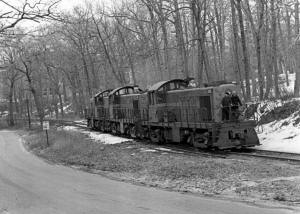
RS1s #462-464-467 Kings Park Hospital c.1970
3.5% grade next to Old Dock Rd.
Photo/Archive: Richard Glueck

RS1s #462-464-467 backing coal freight Kings Park Hospital c.1970
Photo/Archive: Richard Glueck
_small.jpg)
RS3 #1551 Train #4647 westbound at Kings Park State Hospital - 1964 (Schneider-Keller)
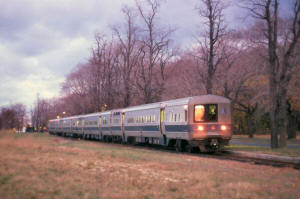
DOT GTE 4 car train 11/13/1977
Photo/Archive: Brad Phillips
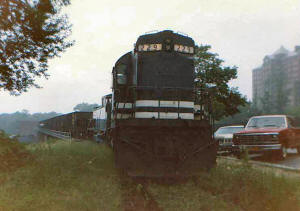
LIRR #229 switching the coal dock
Photo: John Volpi
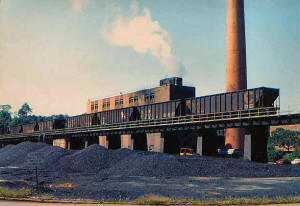
Kings Park Hospital coal dock
Photo: John Volpi
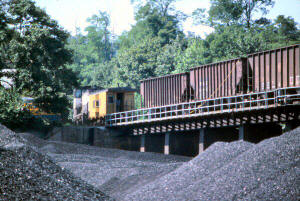
Kings Park Hospital coal train delivery
Photo: John Volpi
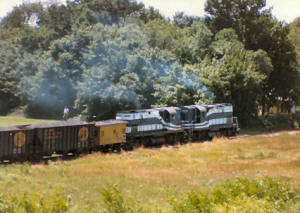
Coal drag at Kings Park Hospital 7/19/1984 Photo/Archive: Al Castelli
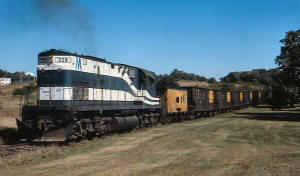
LIRR #228 Kings Parks State Hospital spur
View taken from the hill south of Old Dock Road, looking north toward
Patiky Street c. 1985
Photo/Archive: Dave Flynn

Kings Parks State Hospital coal train delivery
7/19/1984 - Info/Photos/Archive: David Flynn
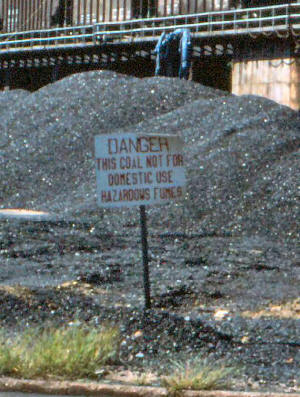
Hazardous Fumes DANGER sign at the
coal dock at the Kings Parks State Hospital
Photo: John Volpi
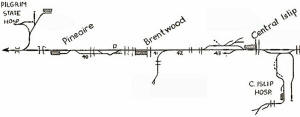
Pilgrim State to Central Islip Hospital sidings map c.1950.
The
Central Islip Hospital siding to the east was to
the new power house and NY
State Warehouse. Other sidings were removed in the early 1950's.
Map: Henry Raudenbush Info/Archive:
Art Huneke
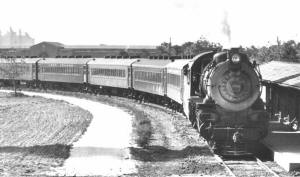
PRR leased E6s #1564 4-4-2 Sunday Hospital Train
Pilgrim State Hospital Station View W 10/13/1946 (R. Dirkes -Dave Keller)
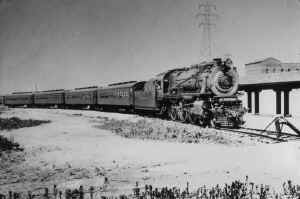
Looking northwest,
G5s #23 is shown here pulling the first run of hospital train #4228
eastbound into the new Pilgrim State Hospital station at Brentwood, NY on
June 24, 1934. The return trip west became train #4225. Over the
years, the numbers of the hospital trains have changed. Note that this
train is indicated on the Emery map following. (Dave Keller
and Art
Huneke data, Dave Keller archive)

A "special
excursion" ticket for the three (3) State Hospitals and not a regular
issue. Normal fares for the train to Pilgrim State Hospital station
were issued as "Brentwood" printed ticket stock. Archive: Richard
Makse
PILGRIM
STATE HOSPITAL: Spur
off Main Line constructed in 1930 for coal delivery to the institution.
Per ETT #1, effective 6/24/34, station with covered shelter in service, and
first passenger train to hospital scheduled. Discontinued as station
stop effective 5/21/78. Spur truncated: 19__? and tracks removed
from upper portion of spur. Lower portion of spur left intact and used
by LIRR as storage track. As of 2013, covered shelter and platform
still in place but heavily overgrown. (Dave Keller's "Long Island
Rail Road Station History" listing)
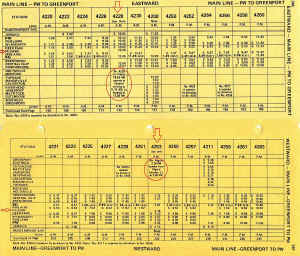 Here
are the eastbound and westbound train listings for service to Pilgrim State
Hospital as they appeared in LIRR Employee Timetable #2, effective 5/20/1974.
The yellow pages indicate Saturdays and Sundays only, with additional notes
indicating the hospital trains run Sundays only.
Here
are the eastbound and westbound train listings for service to Pilgrim State
Hospital as they appeared in LIRR Employee Timetable #2, effective 5/20/1974.
The yellow pages indicate Saturdays and Sundays only, with additional notes
indicating the hospital trains run Sundays only.
The eastbound train, #4228, makes a morning stop at Pinelawn to drop off visitors to the cemetery and a note in the column states that it arrives at Pilgrim switch at 10:55 am, and at the hospital at 11:10. The note continues to state that the train leaves the hospital at 12:20 pm, running light to the timetable-listed Pilgrim switch at 12:40 pm, then continuing to run light, passing SG cabin at 12:45, Central Islip at 12:50 and reaching Ronkonkoma at 12:57 pm where the engine will be run around the train and then laid up for the return trip. If a push-pull train, then there will be no need to run the engine around the train, but it will lay up in the yard nonetheless.
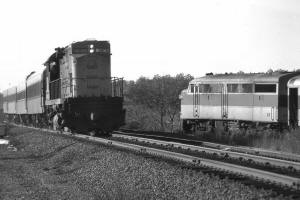 Century
420 No. 217 (note the two different number boards) leads Train 4200 to
Greenport, with one ex-B&M P74B coach and three P72s, past Train 4228 west
of Pine-Aire station on December 28, 1975. Train 4228 (with FA1m 618 on the
west end and Century 420 No. 210 on the east end) was the Sunday-only
Jamaica to Ronkonkoma via Pilgrim State Hospital run. He had already dropped
the visitors off at the platform up the branch and had come back down to the
main track to continue on its now-non-revenue trip to Ronkonkoma. Later that
afternoon, it will return light as Train 4253 to Pilgrim, pick up its
passengers, and continue west to Jamaica. Info/Photo/Archive:
Jeff Erlitz
Century
420 No. 217 (note the two different number boards) leads Train 4200 to
Greenport, with one ex-B&M P74B coach and three P72s, past Train 4228 west
of Pine-Aire station on December 28, 1975. Train 4228 (with FA1m 618 on the
west end and Century 420 No. 210 on the east end) was the Sunday-only
Jamaica to Ronkonkoma via Pilgrim State Hospital run. He had already dropped
the visitors off at the platform up the branch and had come back down to the
main track to continue on its now-non-revenue trip to Ronkonkoma. Later that
afternoon, it will return light as Train 4253 to Pilgrim, pick up its
passengers, and continue west to Jamaica. Info/Photo/Archive:
Jeff Erlitz

The westbound train, #4253, leaves at 2:15 pm from Ronkonkoma where it's been laying up since arriving there at 12:57 pm. It runs light westbound passing Central Islip at 2:22 pm and SG cabin at 2:27 pm. Notes in the column indicate arrival at Pilgrim switch at 2:34 pm. It doesn't give an arrival time at the hospital but states that it leaves the station there at 3:05 pm. The timetable listing shows the westbound run arriving at Pilgrim switch at 3:16 pm then heading to Jamaica, making an afternoon return stop at Pinelawn to pick up visitors returning from the cemetery. (You'll notice that most of the morning and afternoon trains make a Pinelawn station stop for cemetery visitors.)
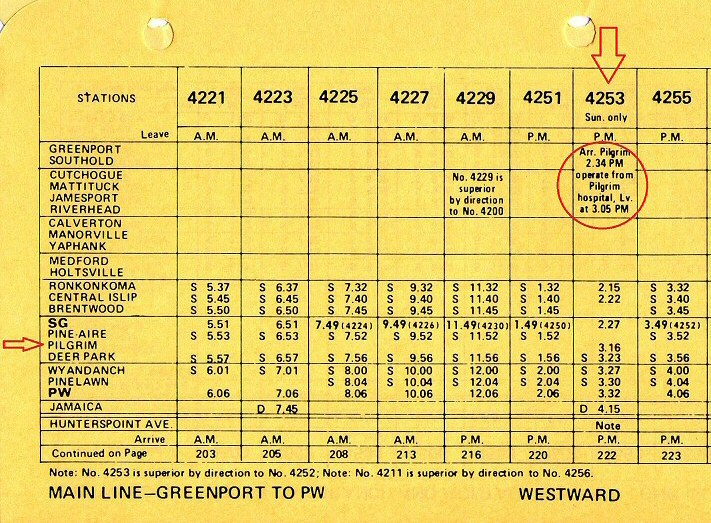
Note
that while the eastbound train was numbered #4228 in 1974, it had changed to
#4236 by the last day of service on May 21, 1978.
The westbound train
number, however, remained the same. (Dave Keller data and archive)

Map of MP 38 to MP 39 showing the Edgewood State Hospital spur/siding at the left, the former Edgewood station site in the center and the Pilgrim State Hospital spur/siding at the right, effective May, 1958. The Pilgrim State Hospital spur/siding is continued on the next map at the right, showing the power plant, related sidings and station location. (Robert Emery map, Dave Keller archive)
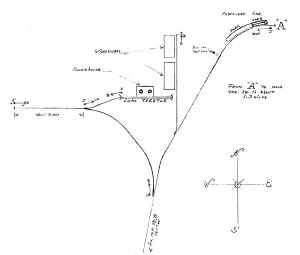
Emery map Pilgrim State Spur - 5/1958
Archive: Dave Keller
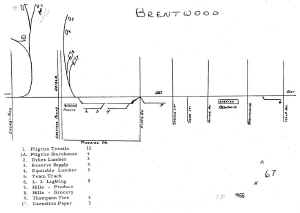
LIRR 1966 map Brentwood/Pilgrim State spur
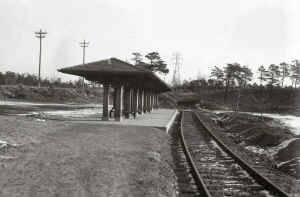
Pilgrim State Hospital Station
1/29/1946 view E (F. W. Weber photo, Dave Keller archive and data)
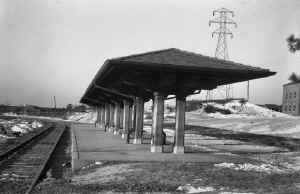
Pilgrim State Hospital Station 1/29/1946 view W (F. W. Weber photo, Dave Keller archive and data)
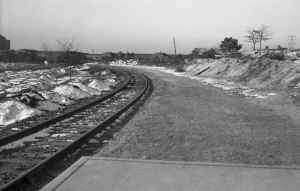
Pilgrim State Hospital Cinder Platform View W 1/29/1946 (F. W. Weber photo, Dave Keller archive and data)
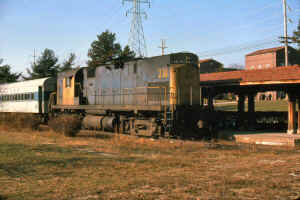
C420 #210 Pilgrim State Hospital Station Brentwood 12/28/1975 (Madden-Keller)
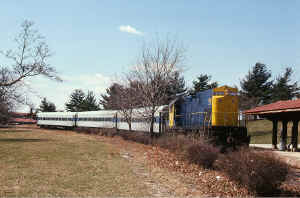
C420 #226 Pilgrim State Hospital Station Brentwood
3/1976 Archive: Dave Keller
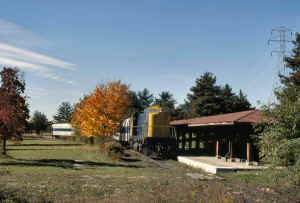
C420 #222 Pilgrim State Hospital Station Brentwood
10/1977 Photo: Art Huneke Archive: Dave Keller
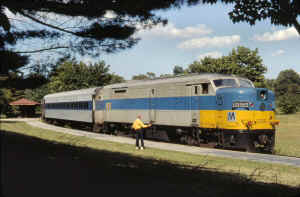
FA2 #605 Pilgrim State Hospital Station Brentwood
7/1977 Archive: Dave Keller
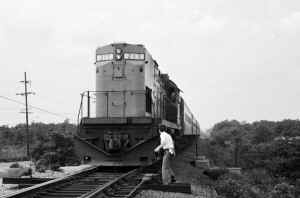
Train #4244 entering Pilgrim State Hospital 9/01/68
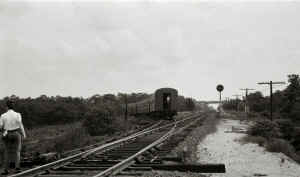
Train #4244 clearing Pilgrim State Hospital 9/01/68
In this view, the head end man stands at the switch waiting to normal it while the rear end man pulls two on the communicating whistle to stop the train clear of the main. Barely visible at the right is conductor at the T box, ready to report the train #4244 clear of the main at Pilgrim.
Note that signal 388, shunted by the open switch, is improperly displaying a Permissive-Block instead of a Caution aspect--the lower marker light is burned out. 388 was the distant signal to SG block station but also served as a distant switch indicator. Info/photos: Richard Makse
The Last Passenger Train Service to Pilgrim State Hospital
The last passenger train service to Pilgrim State Hospital in Brentwood, NY was on May 21, 1978. It consisted of eastbound, Sunday-only train #4236 and westbound Sunday-only train #4253.
Until
recent years when the LIRR renumbered many trains, #200-series trains were
Ronkonkoma / Main Line trains (i.e. #204/#211 were the eastbound and
westbound daily run to Greenport and back). The number "4"
preceding the train number designated the train as a Saturday / Sunday /
Holiday (or all three) train. The Pinelawn Cemetery trains were
Saturday-Sunday trains but the Pilgrim State Hospital train was Sunday-only,
making the additional stop at Pinelawn in each direction.
There was
no means to turn the train at Pilgrim nor was there a run-around track, so
the train would nose into the platform, unload the passengers, then, running
light, back out onto the Main in a westbound direction, clear Pilgrim
switch, reverse direction and head east to Ronkonkoma where the train
entered the yard, the locomotive would be cut off, run around the train
either via the wye or a siding track and coupled onto the west end.
When it was
time to head back west in the afternoon to pick up the returning riders who
visited patients at the hospital, the train would again clear the Pilgrim
switch, reverse direction, back eastbound into the spur up to the station,
load the passengers, then head west.
They got smart when they began to use push-pull service there, because it eliminated that need to turn the train. There was NOTHING at Pilgrim station or at nearby Pine Aire at the time, that could occupy hours of layover. (Dave Keller data)
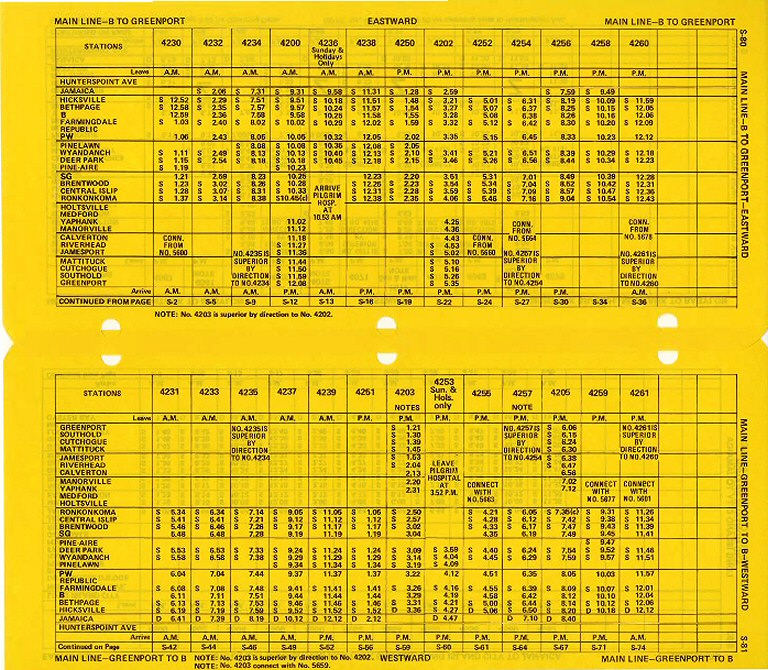
LIRR Employee timetable #4, eff. May, 1977 NO longer shows the light runs to
and from Ronkonkoma. With the use of push-pull trains to the hospital,
the need to run the train out to Ronkonkoma to turn the engine or run it
around the train and lay up until the return trip was no longer necessary.
I gather the LIRR deemed it more cost-effective to let the train layup
either at the hospital platform or on the Pine Aire siding, north of the
Main, until departure time. (Jeff Erlitz archive, Dave Keller data)
The last Ronkonkoma Branch
timetable showing the Sunday* round trip: September 12, 1977 - Revised
November 28, 1977
#4236 Eastbound: Leave Jamaica 9:58 AM; Hicksville 10:18 AM; All stops to
Deer Park (Except Republic) 10:45 AM; Arrive Pilgrim Hospital 10:53 AM
#4253 Westbound: Leave Pilgrim Hospital 3:52 PM; Leave Deer Park 3:59 PM;
All stops to Hicksville (Except Republic) 4:27 PM; Arrive Jamaica 4:47 PM
The Ronkonkoma Branch (Monday) May 22, 1978 Branch Timetable no Longer Shows
the Pilgrim State Hospital service - Discontinued/Last Runs on Sunday May
21, 1978?
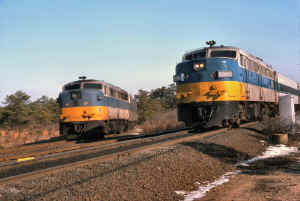
In this view looking NE, ALCO FA2 #607 leads westbound push-pull train from Ronkonkoma past ALCO FA1 #618 with westbound Pilgrim State Hospital push-pull train on hospital spur west of Pine-Aire, NY on December 28, 1975. The remains of an early snowfall are still visible on the cold ground. (Madden-Keller)
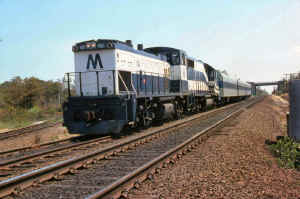
MP15ac #154 GP38-2 #276 Train #4236 Last eastbound to Pilgrim State Hospital - Pine Aire Siding view NE 05/21/1978 (Madden-Keller)
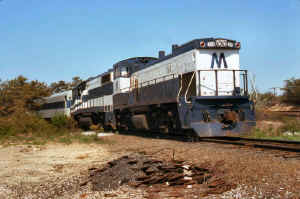
MP15ac #154 and GP38-2
#276 Train #4253 LAST RUN westbound
from Pilgrim State Hospital on Spur view SE 5/21/78 (Madden-Keller)
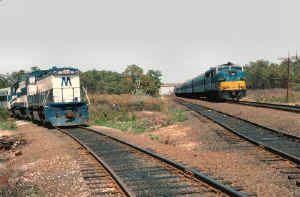
MP15ac #154 and
GP38-2 #276 Last day passenger service Train #4253 westbound
to Pilgrim State Hospital at junction with FA1 #616 Train #4203
westbound at Pine Aire 5/21/1978
(Madden-Keller)
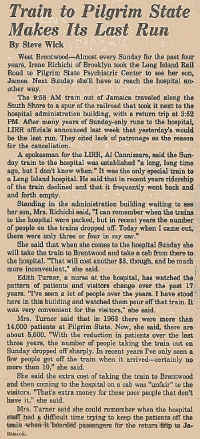
"Train to
Pilgrim State Makes Its Last Run"
Newsday May 22, 1978 Page 16 by Steve
Wick
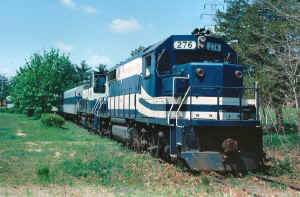
GP38-2 #276 and MP15ac #154 Last day Train #4253 passenger service to
Pilgrim State Hospital Pine Aire 5/21/1978 (Madden-Keller)
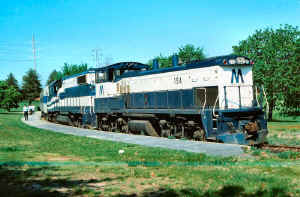
MP15ac #154 and GP38-2 #276 Last day Train #4253 passenger service to
Pilgrim State Hospital Pine Aire 5/21/1978 (Madden-Keller)
Here's
the procedure used on the runs up the spur in the last years as well as on
the last day of passenger service:
The
hospital train eastbound, #4236, would head onto the spur and into the
station with the locomotive(s) on the east end. After the passengers
had left, the train was backed westbound out onto the Main Line, a reverse
move made, and then headed eastbound to Ronkonkoma where the locomotive(s)
was (were) run around the train on the wye and all laid up in the yard for
the return trip to the hospital as westbound train #4253. At the
junction, the train was BACKED into the hospital spur in preparation for the
scheduled westbound return train with the locomotive(s) on the west end.
Why there were TWO locomotives on this last run is a mystery, unless one of
the engines was giving trouble or was expected to possibly give trouble and
the LIRR was playing it safe. Info: Dave Keller
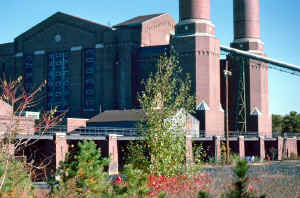
Pilgrim Spur View NW 10/20/1987 Photo: Edward Hand
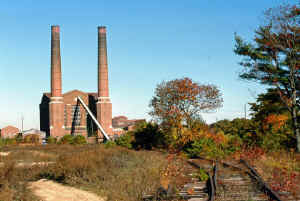
Pilgrim Spur View N 10/20/1987 Photo: Edward Hand
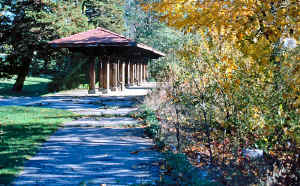
Pilgrim Station View E 10/20/1987 Photo: Edward Hand
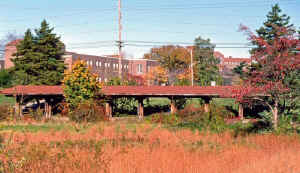
Pilgrim Station View N 10/20/1987 Photo: Edward Hand
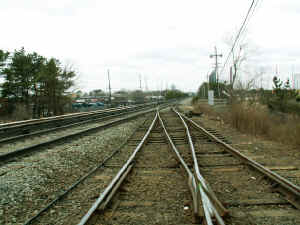
1. Pilgrim Switch
showing the double-tracked, electrified Main Line at the left, the Pine Aire
siding in the center foreground and the hospital spur in the right
foreground. 3/25/2006
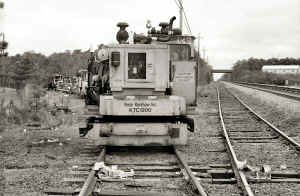
2. The southern portion of the Pilgrim Spur was left intact and used for storage. In this view taken on March 25, 2006 looking east towards the Sagtikos Parkway overpass, track cars are laying up on the spur. The Pine Aire siding is to the right of the MOW track cars, the double tracked, electrified Main Line is at the far right and the LIRR electric substation is visible in the right background. (Pat Masterson photo, Dave Keller archive and data)
In addition to LIRR personnel, a small army of firemen from neighboring communities responded to the emergency remaining through the night until all passengers and injured had been removed from the wreckage.
There was one fatality: ticket collector Donald J. Wheeler of North Babylon. LIRR police joined with Suffolk County authorities to pinpoint the cause of the derailment. Verdict: Unknown youths deliberately reversed the switch which caused the train to leave the tracks at the Pilgrim State Hospital spur.
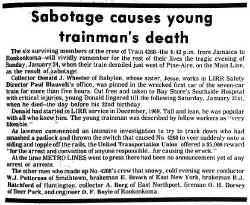
"Sabotage causes
young trainman's death" 01/24/1971 Collection: Al Castelli
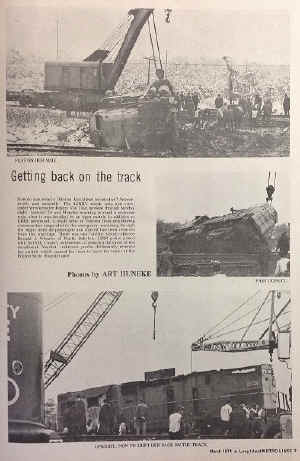
Long Island METRO LINES page 7 Photos: Art Huneke Collection: Al Castelli
Referring
to Emery's map, you'll note the location of the Pilgrim switch and the
hospital spur leading directly off the single-tracked Main Line. As a result
of a deadly, vandal-related derailment that occurred at this location on
January 24, 1971, the old, stone, overgrade crossing of the former
private road just to the west of here was solidly filled in and Pine Aire
siding was installed. Access to the Pilgrim switch was moved from its
former, direct, Main Line location to a point along the new siding, to
prevent this sort of tragedy from happening again. (Dave Keller data)
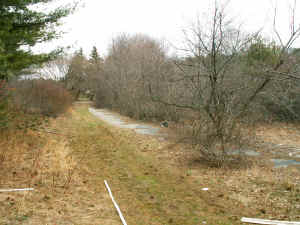
3. Pilgrim State Hospital ROW 3/25/2006
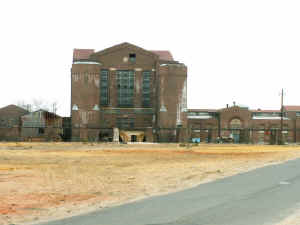
4. Pilgrim State Hospital powerhouse - view N 3/25/2006
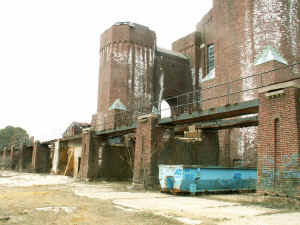
5. Pilgrim State
Hospital powerhouse coal
trestle - view W 3/25/2006
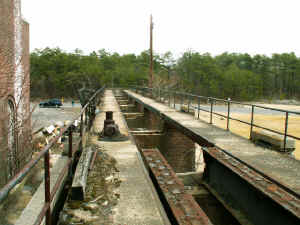
6. Pilgrim State
Hospital coal trestle
track level - view E 3/25/2006
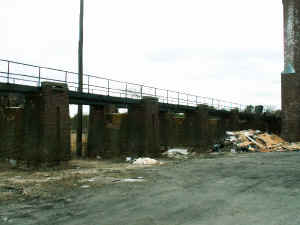
7. Pilgrim State Hospital power house coal trestle - view SW 3/25/2006
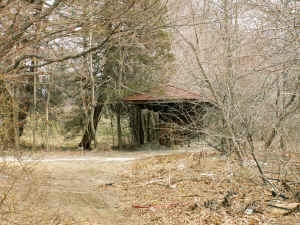
8. Pilgrim State Hospital station shed - view E 3/25/2006
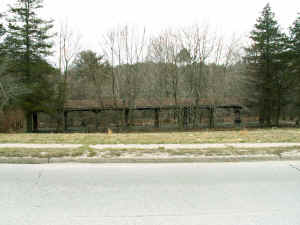
9. Pilgrim State Hospital station shed - view S from G Road 3/25/2006
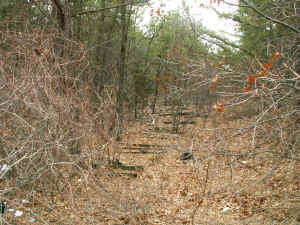
10. Pilgrim State Hospital spur end-of-track - view W 3/25/2006
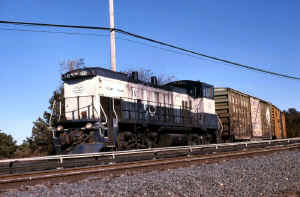
Former LIRR and now New York & Atlantic Railway MP15ac #159 is pulling a string of freight cars westbound off the old Pilgrim State Hospital spur west of Pine Aire in this image from November 17, 1999. While the last passenger train was run on this spur in 1978, coal trains ceased when the hospital's power plant shut down and the station area became completely overgrown in the years following, the lower portion of the spur remained in use to store equipment such as track cars during track work as well as freight cars. The NY&A took over LIRR freight operations on May 11, 1997 with a 20-year lease. MP15ac #159 is shown here removing some stored freight cars from the spur to head back west. This view is northeast. (David Keller data and archive)
